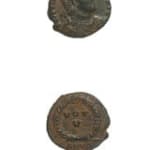Bronze Coin of Emperor Jovian, 363 CE - 364 CE
Bronze
C.4781
Further images
Obverse: DN IOVANVS PF AVG; Diademed, Draped and Cuirassed Bust of the Emperor Facing Righ Reverse: VOT V; Legend Surrounded by a Wreat Flavius Jovianus was born in 330 A.D....
Obverse: DN IOVANVS PF AVG; Diademed, Draped and Cuirassed Bust of the Emperor Facing Righ
Reverse: VOT V; Legend Surrounded by a Wreat
Flavius Jovianus was born in 330 A.D. at Singidunum (modern Belgrade). His father was the commander of imperial bodyguard of Constantius II. Jovian began his career as a member of that same force, serving first under Constantius II, then Julian. By 363, following his father's example, he rose to become commander of the guards. After the death of Julian in June of the same year, his troops elevated Jovian to the position of emperor. The new emperor had little time to rest, for when the Persian king Sapor II (Shapur II) heard that the new Roman emperor was the second choice, he increased his attacks on the Roman forces in Mesopotamia. Jovian was eager for peace, so much so that he agreed to withdraw from the five provinces beyond the Tigris annexed by Diocletian, and leaving to the Persians several strategic fortresses as well as a large part of Armenia. Needless to say, this treaty was considered a disgrace, the result of a weak and feeble emperor who could not bear the pressures of office. Jovian condemned the pagan faith of his predecessor Julian and restored subsidies to the Christian church that were initiated under Constantine the Great. Well aware of just how fragile his position was as long as he remained away from the capital, Jovian sought to get back to Constantinople. Jovian departed Antioch in the winter, making his way across Asia Minor. However, he would never reach his destination. On the border of Bithynia and Galatia, in the town of Dadastana, he was discovered dead in his bed. While there are no suggestions of a violent demise, the circumstances of his death remain a mystery.
How many hands have touched a coin in your pocket or purse? What eras and lands have the coin traversed on its journey into our possession? As we reach into our pockets to pull out some change, we rarely hesitate to think of who might have touched the coin before us, or where the coin will venture to after it leaves our hands. More than money, coins are a symbol of the state that struck them, of a specific time and location, whether contemporary currencies or artifacts of a long forgotten empire. This stunning hand-struck coin reveals an expertise of craftsmanship and intricate sculptural detail that is often lacking in contemporary machine-made currencies. This ancient coin is a memorial to an emperor’s reign passed from the hands of civilization to civilization, from generation to generation that still appears as vibrant today as the day it was struck.
Reverse: VOT V; Legend Surrounded by a Wreat
Flavius Jovianus was born in 330 A.D. at Singidunum (modern Belgrade). His father was the commander of imperial bodyguard of Constantius II. Jovian began his career as a member of that same force, serving first under Constantius II, then Julian. By 363, following his father's example, he rose to become commander of the guards. After the death of Julian in June of the same year, his troops elevated Jovian to the position of emperor. The new emperor had little time to rest, for when the Persian king Sapor II (Shapur II) heard that the new Roman emperor was the second choice, he increased his attacks on the Roman forces in Mesopotamia. Jovian was eager for peace, so much so that he agreed to withdraw from the five provinces beyond the Tigris annexed by Diocletian, and leaving to the Persians several strategic fortresses as well as a large part of Armenia. Needless to say, this treaty was considered a disgrace, the result of a weak and feeble emperor who could not bear the pressures of office. Jovian condemned the pagan faith of his predecessor Julian and restored subsidies to the Christian church that were initiated under Constantine the Great. Well aware of just how fragile his position was as long as he remained away from the capital, Jovian sought to get back to Constantinople. Jovian departed Antioch in the winter, making his way across Asia Minor. However, he would never reach his destination. On the border of Bithynia and Galatia, in the town of Dadastana, he was discovered dead in his bed. While there are no suggestions of a violent demise, the circumstances of his death remain a mystery.
How many hands have touched a coin in your pocket or purse? What eras and lands have the coin traversed on its journey into our possession? As we reach into our pockets to pull out some change, we rarely hesitate to think of who might have touched the coin before us, or where the coin will venture to after it leaves our hands. More than money, coins are a symbol of the state that struck them, of a specific time and location, whether contemporary currencies or artifacts of a long forgotten empire. This stunning hand-struck coin reveals an expertise of craftsmanship and intricate sculptural detail that is often lacking in contemporary machine-made currencies. This ancient coin is a memorial to an emperor’s reign passed from the hands of civilization to civilization, from generation to generation that still appears as vibrant today as the day it was struck.





